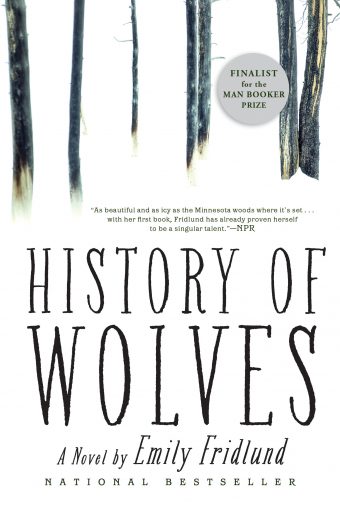| <- Back to main page |
(HarperCollins)

Minnesota writer Emily Fridlund’s debut novel History of Wolves is a contemporary coming-of-age tale that contains elements of a gothic fairy tale, a psychological thriller, and a crime drama. With precision and grace, Fridlund crafts a story that is at once bleak and beautiful, heartfelt and haunting.
History of Wolves follows teenage Linda, who lives with her parents in an isolated cabin in the woods of a small town in northern Minnesota. The three of them are the only remaining members of a counterculture commune that fell apart when Linda was a young child. Frustrated with her home life and friendless existence at school, Linda has learned to be self-sufficient, burying deep her desperation to be wanted — to belong. Linda is a sharp observer, talented at recognizing the nuances of the people around her: “I could do that. Give people what they wanted without them knowing it came from me.”
Linda grows up roaming the woods surrounding her cabin, learning their subtleties as a survivalist might. The woods serve as an escape from thought and emotion — a place to simply exist and observe. Linda appreciates the indifference the woods show her, reflecting:
It was never magical to me: I was never so young, nor so proprietary, as to see it like that. Year by year, the woods just kept unfurling and blooming and drying up, and its constant flux implied meanings half revealed, half withheld—mysteries, yes, but mysteries made rote by change itself, the woods covering and re-covering its tracks.
There are no whispering trees in this forest, no secret paths leading to self-discovery, and the setting is all the more effective for it. Vast, imposing, and in constant flux, the woods serve as a landscape for Linda’s struggle to find connection, highlighting her physical isolation as well as the figurative isolation of her naiveté and youth.
When Linda is fifteen, a young mother and her four-year-old son, Paul, move in across the lake, successfully breaking through the monotony and loneliness of Linda’s daily life when Linda begins nannying Paul for the summer. Linda begins to find the connection she has been looking for, initially unaware of how hungry she had been for it. During a night camping with the mother, Patra, and Paul, Linda realizes what she has found:
Later when I woke up, I found Patra had curled up around Paul. Back to me. But I could feel her curved spine through her jacket when I pushed in closer, all those little vertebrae linked up, all those bones laid out, like a secret.
. . . I could hear Paul and Patra, breathing in syncopation. Happy. I was happy. I barely recognized the feeling.
When Patra’s dogmatic husband joins the family a few months later, Linda starts piecing together troubling truths about the parents that threaten the small sense of peace she has found within their home — truths that have devastating consequences.
Fridlund’s prose is cold and bleak, perfectly encapsulating the bitter winds and frozen landscapes of Minnesotan winters. Describing the changing of the seasons, she writes: “Winter collapsed upon us that year. It knelt down, exhausted, and stayed.” At the same time, her writing possesses an understated elegance. Delicate and lyrical, it is clear that her words have been carefully chosen to create a style that is stark yet full of depth. Formally, Fridlund uses heavy foreshadowing and jumps in time to tell Linda’s story, relating the events of that critical summer in a non-linear order. Readers learn on the second page that Paul dies, and a pulsing undercurrent of tension and pain build throughout the novel as the details of his death are slowly revealed. The furthest time jump forward finds Linda at age 37 telling her story, and it is clear that trauma and guilt have shaped the course of her life.
In an interview for BookBrowse, Fridlund says she wrote the first chapter of History of Wolves as a short story at a writer’s workshop as a way to examine ideas of visibility, power structures, and human connection through the voice of a teenage girl longing to be seen. That chapter won the McGinnis-Ritchie award, and Fridlund realized there was more to the story she wanted to tell. Fridlund, who grew up in Edina, MN and currently resides in New York, traveled to northern Minnesota to research the setting of her novel, blending memory, reality, and imagination to create a landscape both recognizable and invented. Fridlund also drew on influences such as Charlotte Brontë, Virginia Woolf, F. Scott Fitzgerald, and Annie Dillard to explore gender, power, family, narrative structure, and story-telling in her work. Following the release of History of Wolves, Fridlund published a collection of stories, Catapult, a Mary McCarthy prize winner. Fridlund is also currently a senior lecturer at Cornell University in the Department of English. A finalist for the 2017 Man Booker Prize, History of Wolves proves that Fridlund is a fierce new talent able to transcend genre and captivate readers with her meticulous command of language. With its quiet melancholy and desolate beauty, History of Wolves will linger with readers like a winter chill. It is a story that settles into the bones as well as the heart.
- Courtney Rust